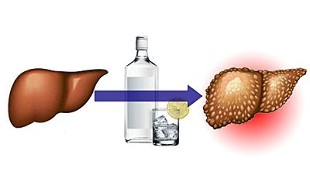The most well-known consequence of alcohol consumption is liver disease. There are many myths about the lesser dangers of drinking vodka, beer or wine. All alcoholic beverages contain ethanol, a potentially toxic substance, so there are no small or useful doses.
Negative consequences of alcohol consumption, even in small doses, are possible, but over a longer period of time.
Why is alcohol bad for your health?
If alcohol is drunk frequently and in excess, it can not only lead to addiction, but can also be the cause of many organic diseases. Ethanol itself and its ingredients that occur during the production of alcoholic beverages can be harmful to health.
The following organs are most commonly affected:
- liver (alcoholic liver steatosis, hepatitis, liver cirrhosis);
- stomach (gastric ulcer, dyspepsia);
- colon (colon cancer);
- pancreas (pancreatitis).
Alcohol is highly toxic and addictive. Therefore, it is difficult for many to stop drinking immediately and without consequences. The lethal dose of ethanol is about 8 g per 1 kg of body weight. Therefore, when drinking beer, vodka or beverages, you must remember moderation, and the amount and frequency of consumption. Alcohol is the source of what we call empty calories. Consumption in large quantities leads to the development of excess weight (1 g of ethanol-7 kcal).
Alcoholic beverages contribute to the development of various diseases and worsen the symptoms of existing ones.
Therefore, it is worth drinking in small quantities, you can choose drinks that are potentially less harmful. You should also be wary of certain compounds that exacerbate ethanol toxicity. But even by adhering to these rules, the negative consequences of drinking will sooner or later be felt.
What determines the harmfulness of alcohol?
The effect of alcohol on the body depends on various factors. What is important is the type and amount of ethanol consumed, gender, genetic factors, time and manner of consumption, the type of drugs used and the general health condition. Similarly, the effectiveness of treatment depends on alcoholism.
Simultaneous consumption of alcohol and tobacco has an extremely harmful effect on the body.
A strong link between alcohol and development has been proven:
- oral tumors;
- tonsil neoplasms;
- throat cancer.

The risk of developing these tumors increases by 30% in people who drink alcohol. Then, if alcohol is combined with cigarette smoking, the risk increases threefold. Consuming alcohol and smoking cigarettes at the same time increases the risk of negative effects of alcohol and severe hangovers.
One of the most common mistakes in the development of a hangover is drinking alcohol on an empty stomach. This speeds up the absorption of alcohol, and also leads to an increase in hangover symptoms the next day.
The various flavors used, for example, to prepare drinks, as well as combining many types of alcoholic beverages, also contribute to the appearance of a hangover. The slightest hangover occurs after swallowing quality, good vodka.
Ethanol poisoning can also occur in the case of alcohol abuse. Her symptoms are:
- nausea and vomiting;
- dizziness;
- diarrhea;
- dehydration.
Safe drinks - what does it mean?
Numerous scientific studies (from various centers around the world) report the beneficial effects of very small amounts of alcohol on the function of individual organs.
A small amount of alcohol is between 20 and 40 grams of pure ethyl alcohol. We can roughly say that this is:
- one small bottle of beer;
- one glass of wine;
- 40 ml of vodka.
Recommendations should not be considered incentives for alcohol consumption, much less for regular, daily consumption. One should keep in mind the negative consequences of alcohol consumption, even a small amount, which can lead to drug addiction.
Many beers and wines can be induced to study the so-called safe amount of alcohol.
A reasonable daily dose has been approved which should not theoretically cause a negative effect on the human body, for women it is 20 g of alcohol per day, which corresponds to a small can of beer or a glass of wine. In turn, in men, 40 g of alcohol per day. These limits assume consumption no more than 5 times a week. However, even these amounts can be addictive and cause serious damage to health.
It should be noted that a woman is more easily addicted to alcohol than a man. They also have slower metabolic processes due to alcohol withdrawal. A woman who consumes the same amount of alcohol, its concentration in the blood reaches a higher level than a man.
Can alcohol have a positive effect?
It doesn't matter what kind of alcohol each person drinks and in what quantities. Whether it exceeds a safe dose or not, it can still lead to disease and drug dependence. They say it’s never too late to stop drinking, however, the sooner you do it, the better. This way you can avoid its negative impact on the whole body.
Numerous studies have shown that small amounts of alcohol consumed each day increase the amount of so-called good HDL cholesterol. HDL particles work more positively than bad cholesterol (LDL). This is considered to be the only way to remove cholesterol that the body has.Here again it should be noted that the role of alcohol is an exception and is used only in very small doses. Small amounts of alcohol do not affect total cholesterol. According to research, excessive alcohol consumption, on the contrary, leads to an increase in cholesterol parameters
You can often read about the health benefits of drinking wine and beer. They actually contain some substances that can have a positive effect on the body. For example, quercetin and resveratrol, present in red wine, have a beneficial effect on the heart and circulatory system. These are the so-called antioxidants.
However, other foods that are least safe are also a source of antioxidants: red grapes, berries, apples, nuts. The negative consequences of alcohol consumption here will be much more than good.
How many calories and which ingredients do alcoholic beverages contain?
Wine contains 8, 5-18% ethanol. The caloric content of wine depends on its type. Sweet wines have the most calories (about 94-104 kcal per 100 g). Minimum caloric values give dry wine (65-68 kcal per 100 g). The wine contains:
- flavonoids;
- tannins;
- organic acids;
- calcium;
- potassium;
- phosphorus;
- magnesium;
- hardware;
- B vitamins.
Red, dry wine is among the least harmful and low in calories and has the most antioxidants. Although the content of many valuable compounds is quite high, wine is an alcoholic beverage that contains pure ethanol. This means that the negative consequences of consuming alcohol are possible even in this form.

The alcohol content in beer is very diverse - from 0, 2 to 9-10%. Beer, of course, has about 49 kcal per 100 g, dark beer in turn has more calories, because in 100 g about 68 kcal.
Beer contains, in particular, antioxidants and B vitamins, magnesium, potassium, phosphorus. You can find a lot of information about the beneficial effects of beer on the urinary system. But beer is also a source of ethanol. It has a beneficial effect on the urinary system, but it does not outweigh the loss of the organism.
High quality vodka, liqueurs, cognacs contain the highest amount of ethyl alcohol - from 15 to 80%. In addition, they are very high in calories, vodka contains about 220 kcal per 100 g.
In whatever minimal doses alcohol is consumed, it still has a detrimental effect on the whole body. Don't fall for the false facts about the benefits of alcoholic beverages. Alcohol is definitely an unnecessary substance, and sometimes even dangerous in terms of the functioning of organs and systems. Treatment of alcoholism is a very complex and often lengthy procedure that requires special efforts of the patient, relatives and medical staff. The negative consequences of alcohol consumption will be far more serious than the quick pleasure of drinking.
























